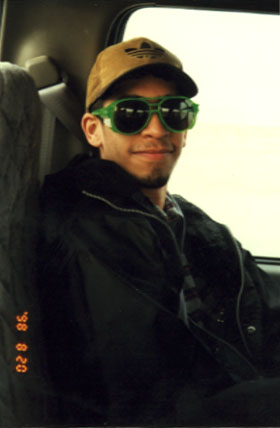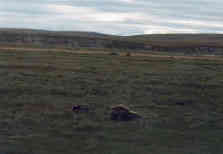18 August, 1998
08/18/98
Safety Training****Betty Pingo
We started early today...6:30 AM for safety training at the BP Oil Fields.
We got there by 7 AM and were greeted by Judy Ann, our teacher for the day.
She, thankfully, led us to coffee (TOY) and then got down to business. We
learned about oil field safety and general rules and regulations to follow
while on the field. I also met Shannon McDade who works for BP and is
sending me some great educational materials to use in my classroom. I
thought we were all treated grandly and would love the opportunity to come
back again someday to thank everyone that was so nice to us. I tell you
what, they know how to cook for their workers.
After training concluded at 3:30 we stopped back by SA-10 and got our gear
to take advantage of the daylight and get some work done. This time we
went to a site on the oil field named Betty Pingo. A pingo is a mound of
soil with an ice core that can reach several hundred meters in elevation in
certain areas. Betty Pingo is about 100 meters tall. Pingos are formed
when saturated soil (usually under dry lake beds) begins freezing from the
bottom, sides, and the top. The pressure from the freezing water forces
the soil in the middle of the core to be pushed upward. They look
prominent on the coastal plains because everything else is so flat.
Wow, I thought I needed my rubber boots around Toolik lake. I really
needed them here on the coast. I was ankle to shin deep in water all
evening. There was one good thing about this though, NO tussocks. It sure
makes the moving about a lot easier. Anyway, Anna and I downloaded the
data loggers and Fritz and Javier did some active layer depth measuring.
We got done about 9:00 and went back to the hotel. The hot shower and the
bed were divine.
The coastal plain is altogether different from the tundra in the foothills
of the Brooks Range. It is flat for as far as the eye can see, except for
buildings and pingos, and has a lot more grass as vegetation. There are a
lot more lakes here as well and a larger variety of bird-life. Seagulls
even live this far north. I was surprised, I thought that sky-rats would
find it too cold here. The scenery here is different but also surreal in a
way. It is so quiet even with all the oil being pumped around. It
reminds me of a Twilight Zone episode where the world ends and no one
bothered to tell us.
JAVIER'S PIECE
We woke up this morning to a fresh breakfast that was hot and delicious;
though fresh hot breakfasts aren't rare at Toolik Lake, it certainly is
something else to have showers and a sink and food all in the same
building.
After breakfast, we went through a very informative course in safety taught
by a kind BP representative in a building that was raised on stilts. This
building was raised so that it wouldn't affect the permafrost underneath
the gravel and effectively melt it, thus collapsing the building. Inside
was like a labyrinth of meeting rooms and atriums where food was served.
They had a snack bar, a real food cafe, and an exercise room. When we
started the class, the instructor didn't recognize where we were staying
(S.A. 10: Service Area 10). She had been working with BP at this site for
well over 10 years. She finally knew where we were staying when someone
told her it must be by the dump. Although this is by no means a fair
description of the facilities at S.A. 10, it does have some validity when
compared with this behemoth of a building. The lecture itself was on
oil-field safety; it ran a tad lengthy, but we were able to get in some
field work at Betty Pingo 1 and Betty Pingo 2. We basically completed the
smaller flux plots and Betty Pingo 1 and 2, and downloaded the data from
the data loggers there.
After this relaxing excursion, we decided to see if we could catch a hot
dinner at this huge mansion on stilts, but were too late and I had to
settle for a "veggie" burger. I ate half of it and followed Dr. Nelson by
eating a good, wholesome, American hotdog.

Javier sports high fashion PPE (personal protective equipment) required to travel through the Prudhoe Bay Oilfields (photo courtesy of Javier Lopez).

A female muskox and calf resting along the side of the Dalton Highway and Sagavanirktok River (photo by Javier Lopez).
Contact the TEA in the field at
.
If you cannot connect through your browser, copy the
TEA's e-mail address in the "To:" line of
your favorite e-mail package.
|
